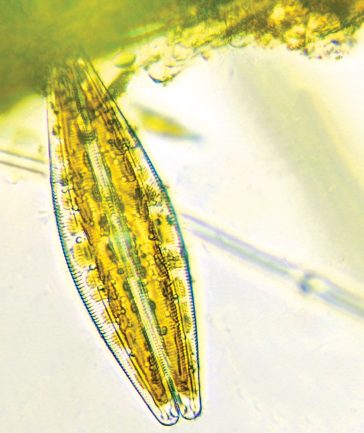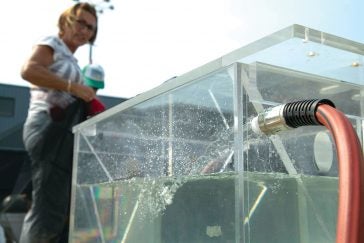The water sampling system for trace metal clean sampling system deployed from the R/V Revelle.
National Aeronautics and Space Administration (NASA) satellites routinely circle the Earth, taking images of the oceans to gather a wide array of information, ranging from temperature and salinity to the abundance of tiny plant-like organisms.

Although easily overlooked because of their microscopic size, these phytoplankton are essential — they supply half the oxygen we breathe, form the foundation of the marine food web, and play a critical role in removing carbon from the atmosphere in a process scientists call the biological pump. Yet, the sensors on these satellites, collecting reams of data for NASA, do not penetrate the ocean’s surface. Consequently, critically important information contained below the surface, needed to fully understand the biological pump, remains unknown.
What happens below the surface, in the deep ocean? How many phytoplankton are eaten and passed through the food web? How many die off and sink, taking carbon to the deep ocean where it can stay for centuries? How much carbon can the ocean take up and how much gets returned to the atmosphere?
In what is being hailed by NASA and the National Science Foundation (NSF) as the first coordinated science campaign of its kind to study the role and fate of plankton, the EXport Processes in the Ocean from RemoTe Sensing (EXPORTS) program seeks to answer these and other questions — a monumental effort to yield greater understanding of the oceanic biological pump and its role in the Earth’s carbon cycle.
The number of URI faculty chosen is phenomenal. While other institutions are represented by multiple people and projects, to land four is unusual and speaks to the high caliber research and innovative approaches the URI scientists bring to the program.Paula Bontempi, Earth Science Division, NASA
Notably, the campaign features 16 projects, four led by University of Rhode Island scientists. Professors Susanne Menden-Deuer and Tatiana Rynearson and Assistant Professor Melissa Omand are at the Graduate School of Oceanography. Professor Bethany Jenkins is at the College of the Environment and Life Sciences. Their projects also provide an invaluable experiential learning platform for graduate students Melanie Feen and Kristofer Gomes as well as postdoctoral fellows Heather McNair, Françoise Morison and Ewelina Rubin.
A large winter phytoplankton bloom is seen in the Gulf of Aden on Feb. 12, 2018.
Paula Bontempi, program scientist for ocean biology and biogeochemistry in the Earth Science Division at NASA headquarters, says the number of URI faculty chosen is phenomenal. While other institutions are represented by multiple people and projects, to land four is unusual and speaks to the high caliber research and innovative approaches the URI scientists bring to the program. The entire EXPORTS campaign involves 55 principle investigators and 29 institutions.
“Obviously, there is a clear and strong synergy with what NASA was planning for the EXPORTS field campaign, and the expertise and ideas brought forward by the URI faculty members, which was obvious to the peer reviewers and the agency,” says Bontempi, a URI alum who earned her Ph.D. in oceanography in 2001. “There’s also a nice blend of exploration-driven science with what we’re studying in EXPORTS.”
Speaking to the broader aims of the campaign, Mike Sieracki, program director in the NSF Division of Ocean Sciences, notes in an agency press release: “The carbon humans are putting into the atmosphere is warming the Earth. Much of that carbon eventually finds its way into the ocean and is transported to the deep ocean, where it is sequestered and will not return to the atmosphere for a long time. This project will help us understand the biological and chemical processes that remove the carbon, and establish a foundation for monitoring these processes as the climate changes.”

EXPORTS cuts across multiple disciplines and took seven years to come to fruition. NASA selected Jenkins and Menden-Deuer to serve on the campaign’s scientific definition team that conceptualized the scope and established the framework. From August 11 to September 15, 2018, more than 100 scientists and crew members sailed out of Seattle on two research vessels, operated by the Scripps Institution of Oceanography, the R/V Revelle and R/V Sally Ride. The first round of field experiments in the EXPORTS campaign was conducted about 1,000 miles west of Seattle, in the open ocean.
In a critically important report released this past October, the Intergovernmental Panel on Climate Change sounded a global alarm. The panel concluded that, unless a worldwide massive effort is marshaled to slow global warming in the next 20 years to keep the overall temperature rise to less than 1.5 degrees Celsius, substantial consequences will result with severe impacts across ecosystems and throughout human communities around the world. The EXPORTS team at URI is working tirelessly to improve the understanding of phytoplankton’s key role in driving the ocean food web and carbon sequestration — at a time in history when mankind desperately needs the information.
Story originally printed in Momentum: Research & Innovation, a publication of the Vice President for Research and Economic Development, with editorial, graphic design and production by the Office of University Research External Relations.
Momentum Magazine